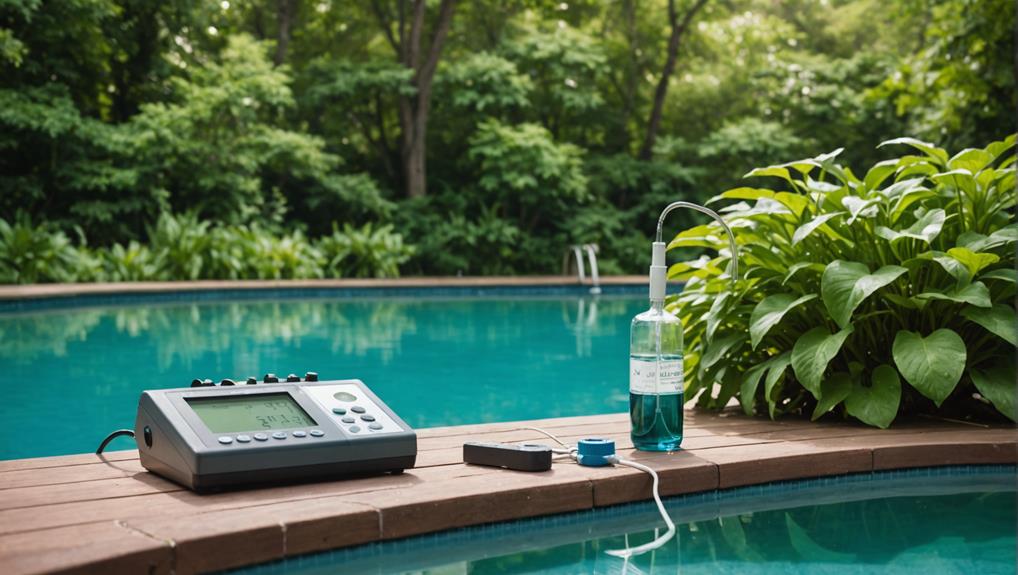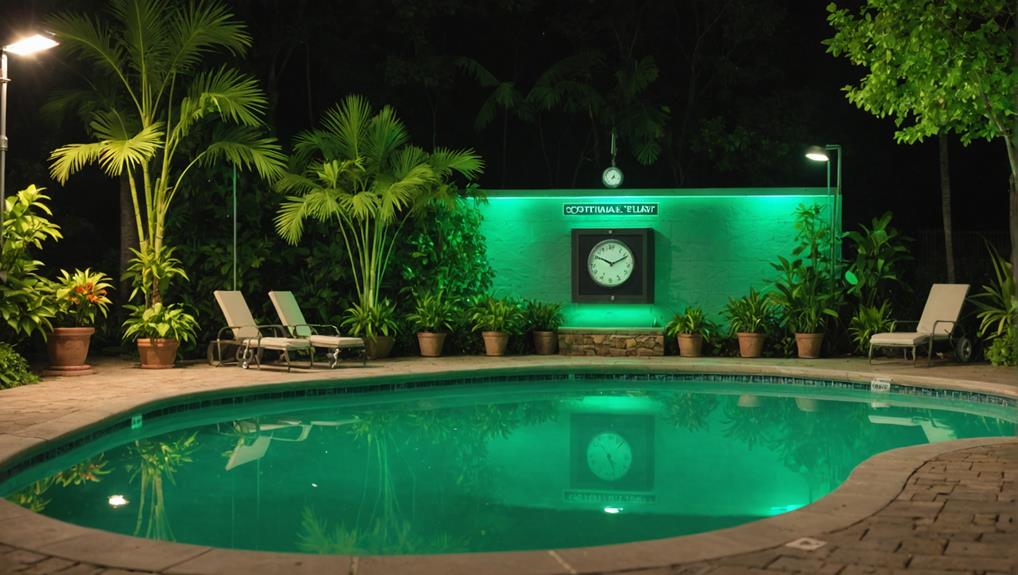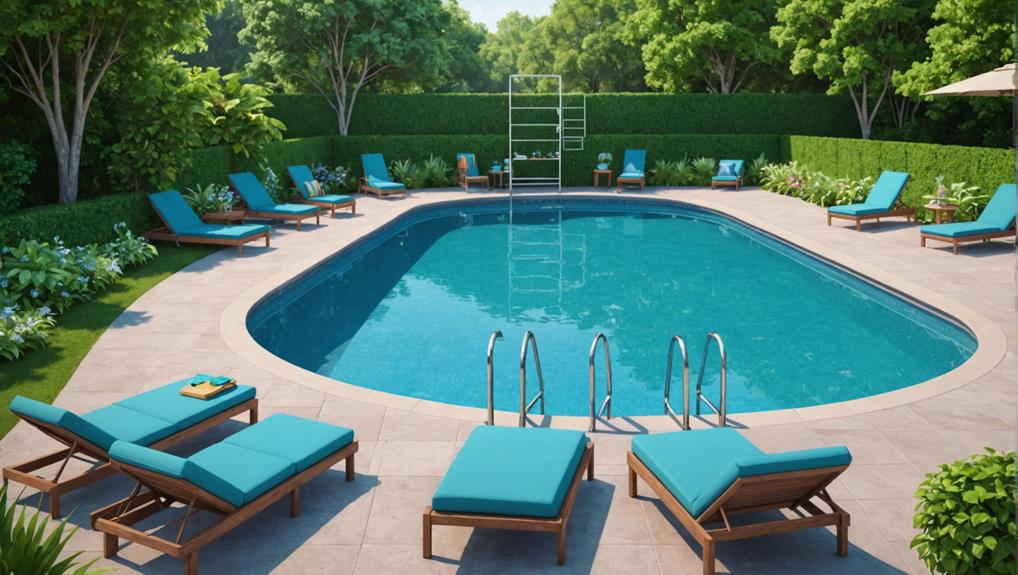You know that maintaining proper chemical levels in your pool water is essential to extending the lifespan of your pool equipment. Even minor fluctuations in pH levels or alkalinity levels can lead to equipment failure, corrosion, and damage. Regularly monitoring and adjusting chemical levels creates a stable environment that allows pool equipment to function efficiently and effectively, reducing maintenance costs in the long run. By understanding the critical role chemical balance plays, you'll be better equipped to prevent corrosion, damage, and premature wear on your equipment, and discover more ways to optimize your pool's performance.
Key Takeaways
- Maintaining proper chemical levels in pool water prevents corrosion, damage, and premature wear on pool equipment, extending its lifespan.
- Chemical imbalances can lead to equipment failure, corrosion, and damage, resulting in costly repairs or replacements.
- Optimizing pH and alkalinity levels creates a stable water environment, preventing sudden shifts in chemical levels that can damage equipment.
- Regular testing and adjustment of calcium hardness levels prevent etching, scaling, and damage to pool equipment and surfaces.
- Balanced water chemistry, achieved through regular testing and maintenance, is essential for preventing damage to pool equipment and surfaces.
Chemical Balance and Longevity
Maintaining a delicate chemical balance in your pool is essential, as even slight deviations can dramatically shorten the lifespan of your equipment.
You need to verify that your pool's chemical levels are within the recommended ranges to prevent corrosion, damage, and premature wear on your pool equipment.
Water chemistry is a complex process, and even minor fluctuations in pH levels or alkalinity levels can have significant consequences.
If your pH levels are too high or too low, it can lead to scaling, etching, or equipment failure. Similarly, improper alkalinity levels can cause pH levels to fluctuate wildly, making it difficult to maintain a stable chemical balance.
By monitoring and adjusting your chemical levels regularly, you can create a stable environment that allows your pool equipment to function efficiently and effectively.
This, in turn, will help extend the lifespan of your equipment and reduce maintenance costs in the long run.
Pool Equipment Lifespan Factors
Your pool equipment's lifespan is heavily influenced by a combination of factors, including the chemical levels in your pool water, which can either protect or destroy your investment.
Proper chemical levels play a critical role in extending the lifespan of your pool equipment. Failure to maintain balanced water chemistry can lead to premature wear and tear on components, resulting in reduced lifespans and increased maintenance costs.
For instance, high pH levels can cause scaling and damage to pumps and filters, while low pH levels can lead to corrosion of metal components.
Proper calcium hardness levels are also vital, as they help to prevent corrosion and damage to equipment, with ideal levels ranging from 200-500 parts per million.
Additionally, regular water testing and balancing are essential to maintaining proper chemical levels and extending the lifespan of pool equipment.
By controlling chlorine levels and maintaining a balanced mix of pool chemicals, you can prevent corrosion and damage to your equipment.
Effective pool maintenance requires attention to these factors to guarantee your equipment operates efficiently and lasts longer.
Common Chemical Imbalance Issues

When you fail to maintain proper chemical levels in your pool, you're likely to encounter a range of issues that can negatively impact your equipment's performance and longevity.
You'll need to be aware of common chemical imbalance issues, including alkalinity level problems, chlorine imbalance effects, and pH level fluctuations, which can all lead to equipment corrosion, damage, and inefficiency.
Alkalinity Level Issues
Fluctuations in alkalinity levels can have far-reaching consequences, including pH swings, eye and skin irritation, and even damage to your pool and its equipment. As a pool owner, maintaining a balanced alkalinity level is vital to prevent these issues.
Here's a breakdown of alkalinity levels and their effects on your pool:
| Alkalinity Level (ppm) | Effects on Your Pool |
|---|---|
| <80 | pH swings, eye and skin irritation, damage to pool equipment |
| 80-120 | Ideal range, stable pH, and effective sanitizer performance |
| >120 | Scaling, cloudy water, and reduced sanitizer effectiveness |
| Low | Increased chlorine demand, higher operating costs |
| High | Reduced water clarity, increased risk of algae growth |
Regular testing of alkalinity levels is imperative, as imbalances can occur suddenly. Correcting them promptly can prevent more severe problems from developing. You can adjust alkalinity levels by adding alkalinity increasers or decreasers, depending on the test results. Remember to also check Cyanuric Acid levels, as they can affect your pool's water clarity and sanitizer performance. By maintaining a balanced alkalinity level, you can safeguard your pool equipment's longevity and keep your water crystal clear.
Chlorine Imbalance Effects
Maintaining a delicate balance of chlorine levels is essential, as even slight deviations can trigger a cascade of problems that impact both swimmer health and pool maintenance.
If you don't maintain proper chlorine levels, you risk exposing swimmers to eye and skin irritation, respiratory problems, and other health issues, especially for those with sensitive skin or allergies.
Inadequate chlorine levels can lead to algae growth, cloudy water, and the spread of waterborne diseases, making it vital to maintain a balance of 1-5 parts per million (ppm).
On the other hand, chlorine levels above 5 ppm can corrode your pool equipment, damage swimwear and pool liners, and cause unpleasant odors.
Failure to maintain proper chlorine levels can also lead to the formation of chloramines, responsible for the strong, unpleasant 'chlorine smell' associated with poorly maintained pools.
Regularly testing and adjusting chlorine levels can prevent these common chemical imbalance issues and provide a safe, healthy, and enjoyable swimming experience in your pool.
Ph Level Fluctuations
You'll also need to keep a close eye on your pool's pH levels, as even slight pH level fluctuations can have a profound impact on your pool's overall health and equipment longevity. pH levels that are too high or too low can cause a range of issues, from equipment corrosion to cloudy water.
| pH Level | Effects on Pool Equipment and Surfaces |
|---|---|
| Above 7.8 | Scaling and damage to pool surfaces and equipment |
| Below 7.2 | Chlorine dissipation, leading to cloudy or algae-filled water |
| Fluctuations | Corrosion of pool equipment, affecting its longevity |
If left unchecked, pH level fluctuations can lead to costly repairs and replacements of pool equipment, such as pumps, heaters, and pipes. Regular testing and adjustment of pH levels can help prevent these issues and ensure the longevity of pool equipment and the overall health of the pool. By maintaining a stable pH level, you can also reduce the need for frequent shock treatments and ensure that your sanitizer is working effectively.
Preventing Corrosion and Damage
By keeping your pool's chemical levels in check, you safeguard your equipment from the corrosive effects of imbalanced water chemistry. When us pool owners fail to properly maintain our pool and spa, we risk causing damage to the equipment that keeps our pool water clean and safe for use.
Equipment Longevity: Imbalanced chemical levels can cause equipment failure, leading to costly repairs or even replacement. By maintaining proper levels, you extend the lifespan of your equipment, saving you time and money.
Corrosion Prevention: Chemical imbalances can cause corrosion on metal components, leading to damage and equipment failure. Properly maintained chemical levels prevent corrosion, ensuring your equipment remains in good working condition.
Pool and Spa Integrity: Imbalanced chemical levels can also compromise the structural integrity of your pool and spa, leading to leaks, cracks, and other damage. By maintaining proper chemical levels, you safeguard your pool and spa from damage.
Optimizing Ph and Alkalinity Levels

Optimizing pH and alkalinity levels is essential to creating a stable water environment that prevents sudden shifts in chemical levels, which can wreak havoc on your pool equipment and surfaces.
When you maintain pH levels between 7.2 and 7.8, you guarantee that your sanitizer works efficiently and effectively. However, if your pH is too high or too low, it can lead to eye irritation, respiratory issues, and even damage to your pool equipment.
You should also test your alkalinity levels regularly using a testing strip to confirm they're within the ideal range of 80-120 parts per million (ppm).
Low alkalinity can cause sudden pH shifts, which can lead to equipment damage and surface etching. If your alkalinity levels are too low, you'll need to add an alkalinity increaser to raise them.
Remember to shock the pool after making any significant changes to your chemical levels to verify all contaminants are oxidized and removed.
Calcium Hardness and Its Effects
As you maintain your pool's chemical balance, you'll want to pay close attention to calcium hardness levels, which play a critical role in protecting your equipment and pool surface from damage.
By controlling calcium hardness, you'll be able to prevent scaling and corrosion, ensuring your pool remains safe and functional.
Now, let's explore the importance of calcium hardness control, balanced water chemistry, and scaling prevention methods in maintaining a healthy and thriving pool.
Calcium Hardness Control
You need to maintain calcium hardness levels between 200-500 parts per million (ppm) to guarantee your pool water is safe for swimmers and equipment alike.
Failure to do so can result in etching, damage to the pool surface and equipment, or even scaling and cloudy water.
To maintain suitable calcium hardness levels, follow these steps:
- Regular pool testing: Check your pool's calcium hardness levels regularly to verify they're within the recommended range.
- Remove debris: Regular cleaning and removal of debris can help prevent calcium hardness levels from fluctuating.
- Maintain your pool: Regularly test and adjust your pool's chemical levels, including calcium hardness, to promote healthy pool water chemistry and equipment longevity.
Balanced Water Chemistry
Maintaining balanced water chemistry, particularly calcium hardness levels, is essential to prevent damage to your pool equipment and surfaces, as well as provide a safe and healthy swimming environment.
When calcium hardness levels fall below 150 ppm, corrosion and scaling can occur, while levels above 600 ppm can lead to cloudy water and scaling.
As a pool owner, it's imperative to understand that calcium hardness levels directly impact the longevity of your pool equipment, including pumps, filters, and heaters, as well as the pool's plaster, tile, and concrete surfaces.
Low calcium hardness levels can cause etching, resulting in a rough, pitted finish and increased risk of algae growth.
To guarantee proper care of your pool, regular testing and adjustment of calcium hardness levels are necessary, as they can fluctuate due to factors like water evaporation, rainfall, and bather load.
Scaling Prevention Methods
By understanding the impact of calcium hardness levels on your pool's equipment and surfaces, you can take proactive steps to prevent scaling, a major concern that can lead to costly repairs and replacements. Scaling occurs when calcium hardness levels are too high, causing mineral buildup that can clog pipes, heat exchangers, and other equipment, reducing their lifespan and efficiency.
To prevent scaling, make sure to maintain proper calcium hardness levels between 200-500 ppm.
Three key takeaways to keep in mind:
- Ideal levels vary by pool finish: Vinyl and fiberglass pools require lower calcium hardness levels (150-250 ppm), while plaster pools require higher levels (200-400 ppm).
- Test regularly: Regularly test your pool's calcium hardness levels to confirm they're within the recommended range.
- Adjust as needed: Make adjustments to your pool's chemical levels as needed to prevent scaling and etching, which can lead to cloudy water, algae growth, and costly repairs.
How Can Proper Chemical Balance Extend the Lifespan of Pool Equipment?
Proper pool chemical balance is crucial for the longevity of pool equipment. Pool chemical balance mistakes such as incorrect pH levels or imbalanced chlorine can lead to corrosion, scale buildup, and premature wear and tear on equipment. Maintaining proper balance can extend the lifespan of pool pumps, filters, and heaters, saving time and money in the long run.
Maintenance Strategies for Longevity

Regular equipment inspections and timely replacements of worn-out parts are essential for extending the lifespan of pool equipment and preventing costly repairs.
You, as a pool owner, require periodic maintenance to verify your equipment is properly cared for. This includes regularly checking for signs of wear and tear, such as corrosion, rust, or damaged seals.
By doing so, you can identify and address potential issues before they escalate into major problems. It's vital to develop a maintenance routine that includes tasks like cleaning filters, lubricating moving parts, and inspecting electrical connections.
Additionally, you should keep a record of your maintenance activities to track the performance of your equipment and plan for future replacements. By staying on top of maintenance, you can substantially reduce the risk of equipment failure and extend its lifespan.
Frequently Asked Questions
What Is the Life Expectancy of Pool Equipment?
You'll find that pool equipment's life expectancy varies, but with regular maintenance schedules, you can extend device longevity, preventing system failure and component wear, thereby ensuring equipment durability that lasts 10 to 25 years or more.
What Should Pool Chemical Levels Be?
You need to maintain ideal pool chemical levels by ensuring a pH balance between 7.2 and 7.8, alkalinity range of 80-120 ppm, chlorine limits of 1-3 ppm, calcium hardness of 200-400 ppm, and stabilizer levels of 30-50 ppm.
How Often Must the Pool Operator Take Chemical Readings?
You must establish a routine testing schedule to maintain accurate results, allowing for timely intervention when needed. Operator training and efficient scheduling are vital to maintain proper chemical balance, with readings taken at least weekly, or more frequently depending on factors like bather load and weather.
How Often Should You Check the Chemical Levels in Your Pool?
You should check chemical levels daily, as part of your routine maintenance, to maintain superior water quality, especially during seasonal fluctuations, requiring owner involvement in monitoring and adjusting levels to prevent imbalance and damage.
Conclusion
It's ironic that something as seemingly trivial as chemical levels can be the difference between a pool equipment lifespan of 5 years or 15.
Yet, it's precisely this oversight that sends many pool owners down a path of frequent replacements and costly repairs.
By maintaining proper chemical balance, you're not only ensuring a safe and healthy swimming environment, but also protecting your investment and saving yourself a world of trouble in the long run.

I’m Max, the founder and chief pool enthusiast behind Pool Pro Tips. As a passionate pool owner and cleaning expert, I created this website to share my knowledge and experience with you, helping you to keep your pool sparkling clean and safe for years to come.

